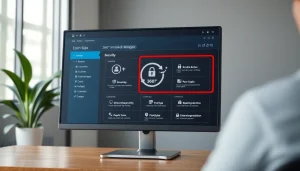Mastering Competitor Pricing Analysis: Strategies and Best Practices for Success
Understanding Competitor Pricing Analysis
What Is Competitor Pricing Analysis?
Competitor pricing analysis is a strategic approach where businesses evaluate the prices that their competitors set for similar products or services. This systematic process involves gathering data regarding competitor pricing models, their trends over time, and how these prices influence market demand and customer perceptions. Essentially, it serves as a foundational tool that enables organizations to position their pricing strategies effectively while considering various market dynamics. By leveraging competitor pricing analysis, companies can make informed decisions that directly impact their competitive stance in the market.
Importance of Competitive Pricing in Business
Pricing is one of the most critical factors influencing consumer behavior. In an increasingly competitive market landscape, understanding how to price your products in relation to competitors is vital for several reasons:
- Market Positioning: Competitive pricing analysis helps businesses understand where they stand relative to their competitors. This knowledge shapes their strategic positioning within their industry.
- Maximizing Profit Margins: By knowing competitor pricing, businesses can adjust their prices to maximize profitability, balancing cost and demand effectively.
- Responding to Market Changes: Market dynamics are constantly shifting. A robust pricing analysis allows businesses to respond swiftly to competitor pricing changes or economic shifts.
Differentiating Between Direct and Indirect Competitors
When undertaking a competitor pricing analysis, it is crucial to distinguish between direct and indirect competitors:
- Direct Competitors: These are companies offering the same or very similar products or services targeted at the same customer base. Analyzing their pricing strategies gives immediate insights into pricing norms within that specific market.
- Indirect Competitors: These are businesses offering substitute products or services that meet the same customer need but not necessarily the same way. Understanding indirect competition is also important as it influences consumer choices and expectations regarding pricing.
Steps to Conduct a Competitor Pricing Analysis
Identifying Competitors and Defining Metrics
Commencing with a solid framework is essential in conducting a meaningful competitor pricing analysis. Here are some key steps:
- Identifying Competitors: List your direct and indirect competitors. Market research tools, industry reports, and customer feedback can assist in this process.
- Defining Metrics: Determine key metrics to evaluate in your analysis, such as competitor pricing points, discounts, promotional strategies, and pricing trends over time. Metrics should align with your business objectives and market conditions.
Data Collection Methods for Accurate Pricing
Data accuracy is paramount for effective competitor pricing analysis. Several methods can be employed for gathering pricing information:
- Surveys and Questionnaires: Direct feedback from customers can provide insights into how customers view competitor pricing versus your offerings.
- Online Tools: Utilize price comparison websites or tools that automatically track competitor pricing to obtain real-time data.
- Competitor Websites: Regularly check your competitors’ websites for the latest pricing models and promotional offers.
Analyzing and Interpreting Pricing Data
Once collected, the data must be analyzed and interpreted to derive meaningful insights:
- Data Visualization: Use graphs or charts to visualize pricing trends, enabling easier interpretation of complex data.
- Comparative Analysis: Compare your pricing against competitors, identifying areas where you fall short or exceed expectations.
- Consumer Behavior Analysis: Understand why competitors price as they do—consider factors such as brand loyalty, perceived value, and customer segments.
Tools and Resources for Effective Analysis
Pricing Analysis Software and Platforms
Numerous software solutions can enhance the accuracy and efficiency of competitor pricing analysis:
- Competera: This platform provides AI-driven price optimization tools that can automatically adjust pricing in response to competitor changes.
- Price2Spy: A pricing intelligence solution allowing businesses to monitor competitors’ prices across multiple channels.
- Wiser: This tool helps businesses understand the competitive landscape by analyzing prices, promotions, and other factors.
Utilizing Market Research Reports
Market research reports are invaluable resources for understanding broader market trends and consumer preferences. These reports typically contain comprehensive analyses of industry sectors, including pricing strategies of competitors and insights into market dynamics.
Leveraging Online Tools for Competitor Insights
Various online tools and resources can aid in gathering and analyzing competitor pricing information:
- Google Trends: This tool can help analyze search interest in specific products or pricing, providing insights into market behaviors over time.
- Social Media Platforms: Monitoring competitors’ social media can reveal promotional strategies and consumer responses to pricing.
Common Challenges in Pricing Analysis
Data Accuracy and Reliability Issues
Ensuring the validity of your data is imperative for making sound pricing decisions. Often, pricing data may be outdated or misrepresented. Utilizing continuous monitoring tools and regularly updating your data sources can mitigate these risks.
Adapting to Market Changes
Market conditions can rapidly evolve, influenced by factors such as economic shifts and technological advancements. Staying agile and being ready to adapt your pricing strategies by continuously monitoring market trends is essential for long-term success.
Balancing Pricing Strategies with Brand Image
While being competitively priced is crucial, it should not undermine your brand equity. A comprehensive pricing strategy should reflect your brand’s values and promise while remaining attractive to price-sensitive consumers. Conducting brand perception studies can help ensure alignment between pricing strategies and brand image.
Case Studies and Real-World Applications
Successful Companies Using Pricing Analysis
Brands like Amazon and Walmart are pioneering success through rigorous competitor pricing analysis:
- Amazon: Amazon uses sophisticated algorithms that dynamically adjust pricing daily based on market demand and competitor price changes, ensuring they remain competitive at all times.
- Walmart: By conducting comprehensive marketplace analyses, Walmart is known for implementing its “Everyday Low Price” strategy, reflecting their commitment to offering value.
Lessons Learned from Competitive Pricing Mistakes
Analyzing pricing failures can provide valuable lessons. For instance, J.C. Penney‘s attempt to shift from discounts to everyday low pricing resulted in a substantial loss of market share, demonstrating the importance of understanding consumer expectations and market conditions before making drastic pricing changes.
Creating a Competitive Pricing Strategy: A Step-by-Step Guide
Developing an effective competitive pricing strategy necessitates a strategic sequential approach:
- Market Research: Conduct extensive market research to understand competitor pricing, customer preferences, and emerging pricing trends.
- Internal Data Analysis: Evaluate your current pricing structure and its performance in relation to competitors.
- Pricing Strategy Development: Formulate a pricing strategy that reflects insights gathered from data analysis while considering brand positioning.
- Implementation: Roll out your pricing strategy across all channels, ensuring that your marketing and sales teams are aligned.
- Continuous Monitoring: Regularly review and adjust your pricing strategy based on ongoing competitive pricing analysis and market conditions.














Post Comment